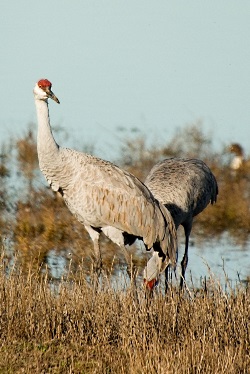
Grus canadensis
Courtesy US FWS,
Justine Belson, Photographer
Cranes of the Swaner Nature Preserve by Michael Flaherty, Nesting cycle of Sandhills Cranes, Swaner Nature Preserve, Park City, UTHi, this is Mark Larese-Casanova from the Utah Master Naturalist Program at Utah State University Extension.
The grace of sandhill cranes draws our attention when we see them in the marshes, meadows, and fields across northern Utah. As one of the tallest birds in the state, the sandhill crane is hard to miss. They’ll glide low over farm fields, with their large slate-grey bodies and red caps making them difficult to mistake with any other bird.
Northern Utah is near the lower end of the sandhill crane’s breeding range, so we’re fortunate to see them. They’ll arrive to Utah beginning in March, and stay for the summer breeding season.
Sandhill cranes develop pair bonds for life, and their choice in mates is influenced by elaborate courtship dances. Crane dances are like awkward avian ballet, with an assortment of bows, flapping wings, and leaps into the air with wings outstretched. At times, sticks or plants are grasped with their long, dagger-like bills and tossed into the air. At up to four feet tall with a wingspan of five feet, the sandhill crane as it dances is quite a sight to see!
Sandhill cranes are often heard before they’re seen. Their loud, rolling trumpets fill the air, even for a couple miles. Males and females call in unison, as a loud duet that helps reinforce their pair bond.
[Sandhill Crane Call Copyright 2006 Kevin Colver, as found at https://collections.lib.utah.edu/details?id=1117102]
Once a suitable nest location is found on the ground or on shallow water, both the male and female toss plant material over their shoulders to build their large nest. As spring now fades to summer, sandhill cranes can be seen strolling through farm fields with their young colts, encouraging them to feed, and protecting them from predators. While the dance of the sandhill cranes has mostly ended, their elegance hangs in our memory until next year.
As Aldo Leopold wrote in A Sand County Almanac, “our appreciation of the crane grows with the slow unraveling of earthly history… And so they live and have their being- these cranes- not in the constricted present, but in the wider reaches of… time. A crane marsh holds a paleontological patent of nobility, won in the march of aeons.”
For Wild About Utah, I’m Mark Larese-Casanova.
[End with Kevin Colver, WesternSoundscape.org sandhill crane call again https://collections.lib.utah.edu/details?id=1117102&q=sandhill+crane]
Credits:
Theme: Courtesy & Copyright Don Anderson Leaping Lulu
Images: YouTube video Courtesy and Copyright Michael Flaherty, Park City. UT
Audio: Copyright Kevin Colver
Text & Voice: Mark Larese-Casanova, Utah Master Naturalist Program at Utah State University Extension.
Additional Reading:
References:
Cornell Lab of Ornithology. Sandhill Crane. All About Birds. https://www.allaboutbirds.org/guide/sandhill_crane/lifehistory
Leopold, A. 1986. A Sand County Almanac. Ballantine Books. https://www.amazon.com/County-Almanac-Outdoor-Essays-Reflections/dp/B00J5SEZ6S
National Wildlife Federation. Sandhill Crane. https://www.nwf.org/wildlife/wildlife-library/birds/sandhill-crane.aspx
Tekiela, S. 2003. Birds of Utah. Adventure Publications, Inc. Cambridge, Minnesota. https://www.amazon.com/Birds-Field-Guide-Identification-Guides/dp/1647554071
Species, Utah Division of Wildlife Resources, Utah Department of Wildlife Resources. Sandhill Crane. https://fieldguide.wildlife.utah.gov/?species=antigone%20canadensis
US Geological Survey. Sandhill crane summer distribution map. https://www.mbr-pwrc.usgs.gov/bbs/htm96/map617/ra2060.html
Photos:
Category:Grus canadensis, Wikimedia Commons, https://commons.wikimedia.org/wiki/Category:Grus_canadensis#mediaviewer/File:Grus_canadensis,_two,_Bosque_del_Apache_NWR.jpg
Category:Grus canadensis, Wikimedia Commons, https://commons.wikimedia.org/wiki/Category:Grus_canadensis#mediaviewer/File:Sandhill_Crane_in_Love^_%28_Grus_canadensis_pratensis_%29_-_Flickr_-_Andrea_Westmoreland.jpg
A Sandhill Crane flying at Sacramento River National Wildlife Refuge, Dayton, California, USA., Courtesy USFWS, Steve Emmons, Photographer, https://commons.wikimedia.org/wiki/Category:Grus_canadensis_in_flight#mediaviewer/File:Grus_canadensis_-Sacramento_River_National_Wildlife_Refuge,_Dayton,_California,_USA_-flying-8.jpg
